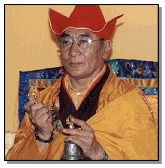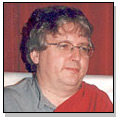


Vajra Acharya Lama Karma Thinley Rinpoche
Organisation: Dechen Community
The Dechen Community is an association of meditation centres and groups belonging to the Sakya and Karma-Kagyu schools of Tibetan Buddhism under the direction of Karma Thinley Rinpoche and Lama Jampa Thaye. There are currently twenty centres and groups belonging to the Community in the United Kingdom and elsewhere.

Lineage: Karma-Kagyu and Sakya [HH 16th Gyalwa Karmapa] [Sakya Trizin Dakshul Thinley Rinchen]
Biography: Karma Thinley Rinpoche, master of the Kagyu and Sakya traditions, was born into the noble family of Bongsar in 1931 in the Nangchen area of Kham, Eastern Tibet. At the age of one month he received refuge and some two years later was recognised by the then head of the Sakya tradition, Sakya Trizin Dakshul Thinley Rinchen, as the tulku (incarnation) of the Sakyapa master Beru Shaiyak Lama Kunrik, thought to be an incarnation of the great Vairocana. At that time he received all the symbols and titles of his rank and authority.
Due to Rinpoche’s rank and the extraordinary profusion of spiritual masters among his extensive set of relations, he received a vast number of teachings during his childhood and youth. From his uncle, the famous yogin Jigje Lama, he received various Kagyu and Nyingma precepts as he did from his two great uncles Shabtrung Rinpoche and Pangchog Rinpoche, heads of Riwoche, the famous non-sectarian monastery. From the great Sakya masters Khangsar Khenpo Ngawang Yonten Gyamtso and Ngawang Tashi Chophel he received a wide range of Sakyapa teachings. Throughout this period Rinpoche accomplished numerous retreats.
Although Rinpoche had inherited the monastery established by his previous incarnation, Beru Kunrig, he in fact lived for much of the time in the Karma-Kagyu monastery established by his uncle, the leading nobleman Bongsar Namkha Dorje. Older relatives remember Rinpoche at this time as a remarkably brilliant young lama, able to accomplish such feats as the memorization of an entire text within one day. Indeed Rinpoche’s scholarship eventually earned him the degree of Khenpo (equivalent to a Ph.D.).
In the mid 1950’s Rinpoche travelled in pilgrimage to such places as Radeng, Samye, Sakya and Lhasa. Subsequently he went to stay at Tsurphu monastery, seat of H.H. the Sixteenth Gyalwa Karmapa. It was at this time that H.H. Karmapa recognized Rinpoche as the fourth Karma Thinleypa. The first three masters of this line were very great Kagyu lamas active during the lives of the seventh, eighth and ninth Karmapas respectively. From that time onwards, Rinpoche was known as Karma Thinley Rinpoche. While at Tsurphu, Rinpoche received many teachings from His Holiness and Drupon Rinpoche, who bestowed upon him the Six Doctrines of Naropa, one of the most profound and revered Kagyu teachings. He also obtained teaching from the yogini Khandro Chenmo who had been the consort of the fifteenth Karmapa.
In 1959, Rinpoche left Tibet in the party of the Karmapa, fleeing from communist oppression. Subsequently Rinpoche became abbot of a newly established nunnery at Tilokpur in 1962. In 1967 he received The Path and Its Fruit, the principal cycle of teachings of the Sakya tradition, from H.H. Sakya Trizin at Sarnath. It was about this time that Rinpoche met his first Western disciples. In 1971 Rinpoche settled in Canada accompanying a group of Tibetan refugees as their spiritual teacher and a year later founded the Tibetan Society to introduce Tibetan culture to Canada. In 1973 Rinpoche founded Kampo Gangra Drubgyud Ling meditation centre in Toronto, named after the first Karmapa’s monastery in Kham. That same year Rinpoche spent three months in Scotland where he met his English student Lama Jampa Thaye for the first time.
Rinpoche returned to India in 1978 to receive the Rinchen Terdzod, the famous collection of Nyingma treasure cycles, from H.H. Dingo Chentze Rinpoche. Four years later he made his first return to Tibet for over 20 years travelling throughout Nangchen visiting his relatives and giving teachings. In 1983 Rinpoche received the Drubthap Kundu, the collected sadhanas of the new tantra schools, from H.E. Chogay Trichen in Lumbini.
Comment: Over the last twenty-five years Rinpoche has founded centres and taught extensively in Canada, the U.S.A., New Zealand and the United Kingdom. He has hundreds of devoted students, both Tibetan and Western. In addition to being an accomplished poet and artist, Rinpoche is a renowned historian, having written an authoritative history of Nangchen and (in English) The History of the Sixteen Karmapas. His major projects at the current time are the continuing supervision of his nunnery Tegchen Legshay Ling in Bodhanath, Nepal and the construction of Sangngak Phodrang in Nangchen.
Particular teachings: Mahamudra and Zhentong Madhyamaka, the works of Sakya Pandita, the collected spiritual instructions of the Kadam tradition, the Konchog Chindu treasure cycle and the One Hundred Initiations of Bari Lotsava. The Thirteen Golden Dharmas and Tsog Shey transmission of the Lam-Dré.
Main Centre:
Centres: See Web site: United Kingdom, Poland and Austria.
• Main Web site: Dechen Community: www.dechen.org
• Email: info@dechen.org
Main Teacher / Regent: Lama Jampa Thaye (b. 1952)

Lama Jampa Thaye met Karma Thinley Rinpoche in 1973. Over the past three decades he has inherited from Rinpoche and other masters such as His Holiness Sakya Trizin a vast range of teachings of the Sakya, Kagyu and Nyingma traditions of Buddhism.
Lama Jampa Thaye completed various meditation retreats, most importantly major retreats on Naro Khachoma and Konchog Chindu. As a result of his studies and practices, he was appointed Rinpoche’s dharma-regent and subsequently given the authority to bestow vajrayana initiations by Rinpoche.

